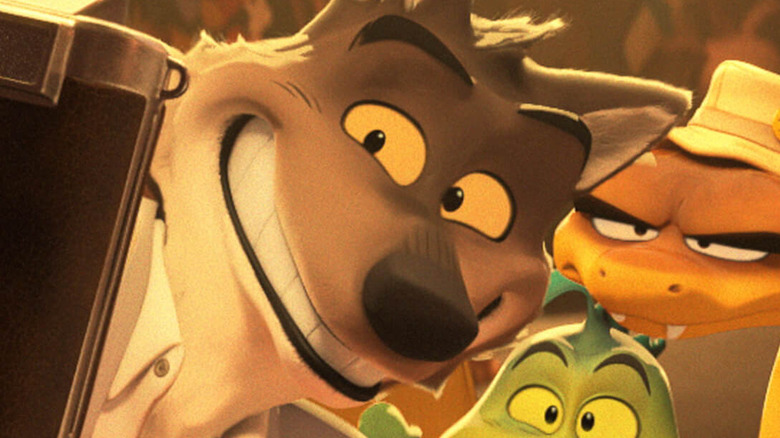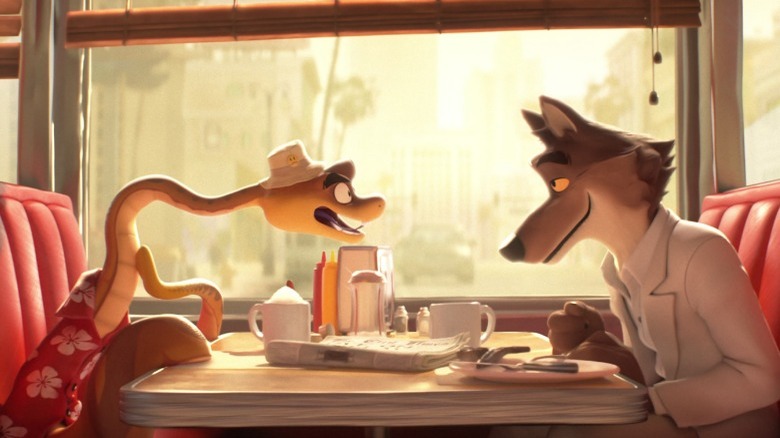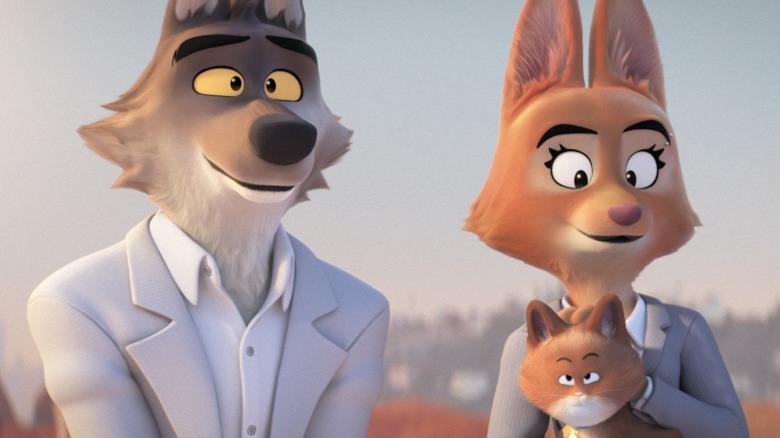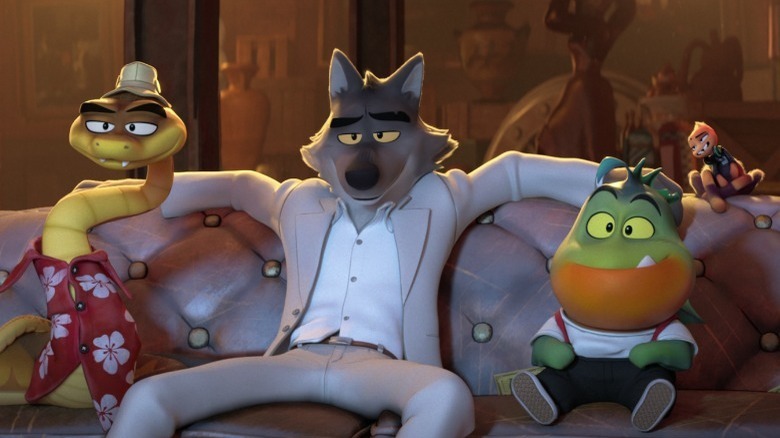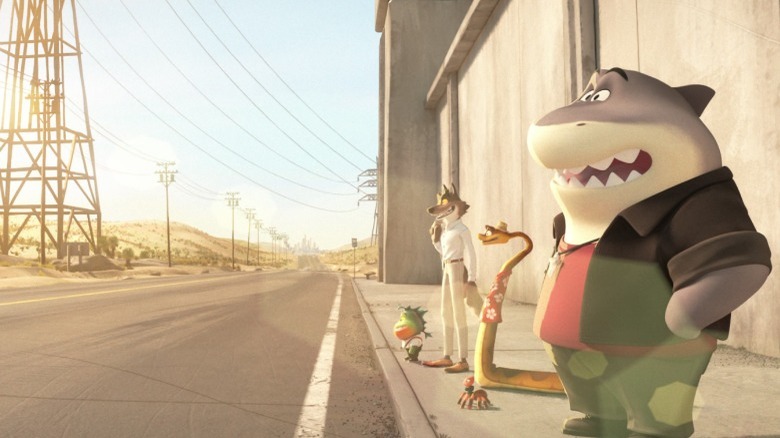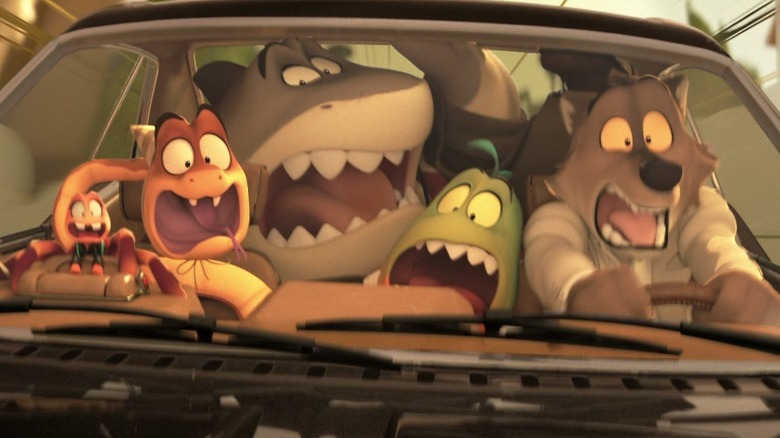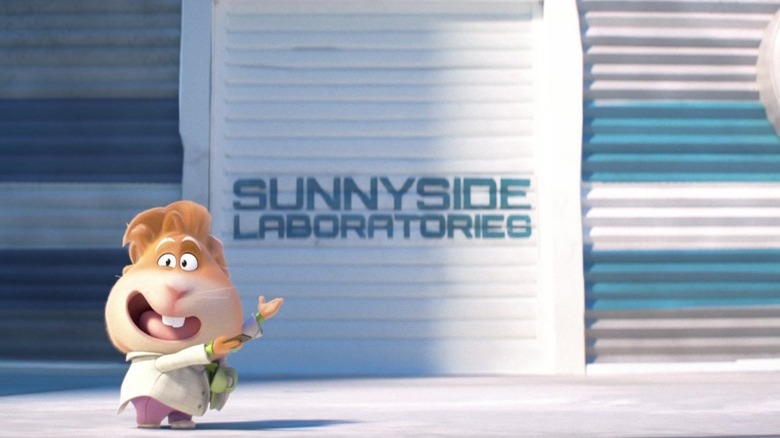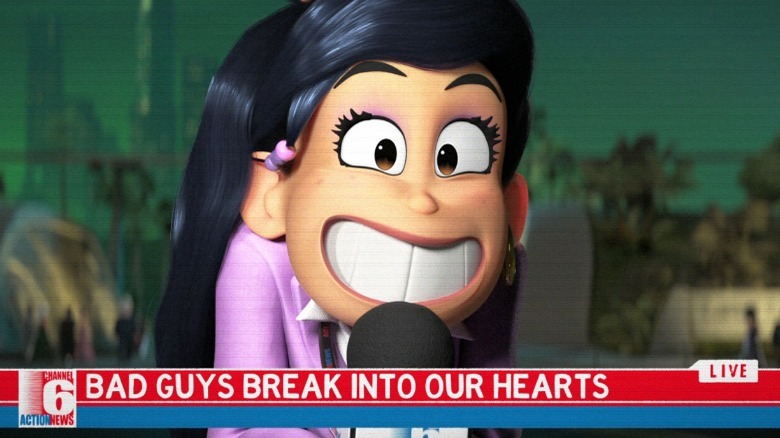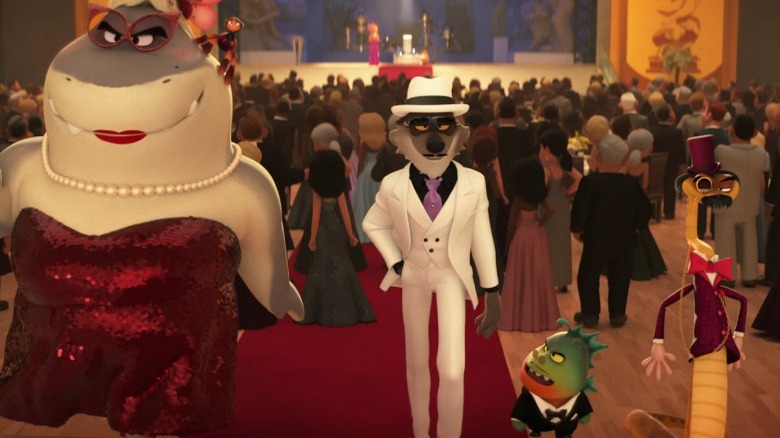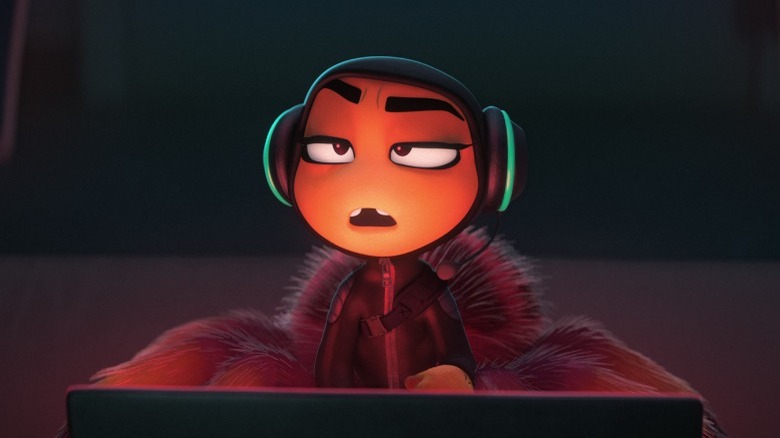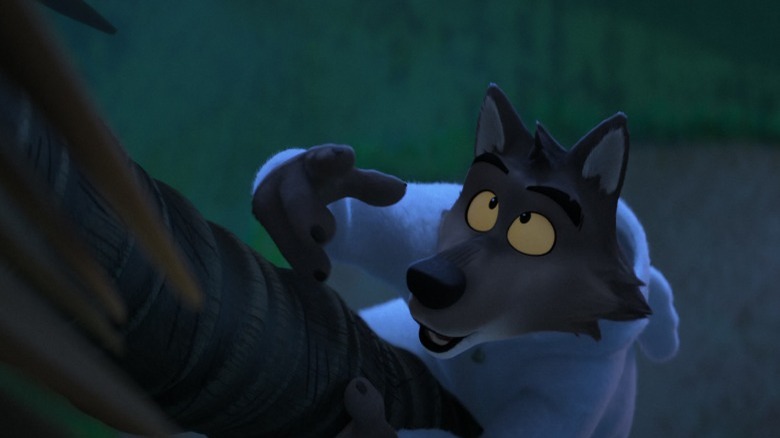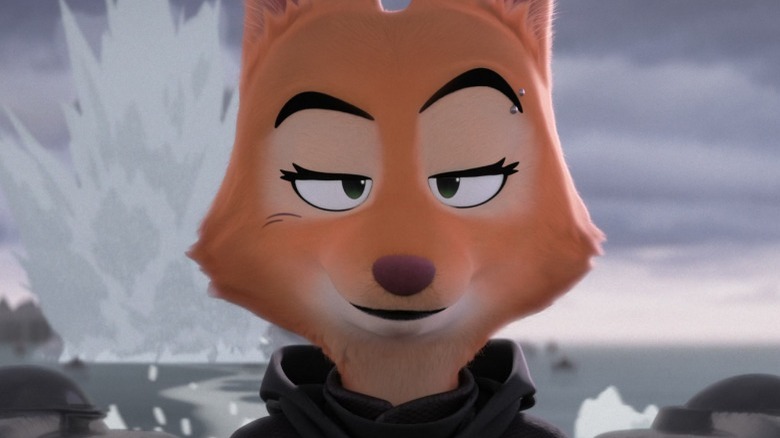Things Only Adults Notice In The Bad Guys
DreamWorks Animation is no stranger to creating kid's movies with a more adult sensibility. For instance, "The Prince of Egypt" deals with more mature themes than most of its animated contemporaries, while "Shrek" manages to sneak a surprising number of adult jokes into a PG movie. And let's not forget that "Chicken Run" is a family comedy set in the animal equivalent of a concentration camp.
However, "The Bad Guys" has an adult sensibility written into its very DNA, since the filmmakers have admitted (via CheatSheet) to basing the movie on a number of R-rated thrillers. Parents needn't worry, though; "The Bad Guys" avoids all the sex and violence and finds creative substitutes for the cuss words. But in this animated film, adults might still catch a hint of the classic heist movies they grew up on. From the pop culture references to plot points that don't make sense, here are all the details that are likely to soar over the heads of kids in the audience.
The Bad Guys is 'Tarantino for kids'
There's something inherently "adult" about "The Bad Guys." That's because one of its main sources of inspiration is the filmography of Quentin Tarantino – movies that are most definitely not for kids. Aaron Blabey, the author of the comics that inspired the movie, told The AU Review, "My original pitch for this was 'Tarantino for kids.'" With this in mind, the filmmakers tried to capture the feel of movies like "Pulp Fiction" or "Reservoir Dogs" — y'know, without all the violence and mayhem. Along the way, they included a few nods to Tarantino.
Right from the opening shot, adults will immediately get Tarantino vibes. "The Bad Guys" begins with Wolf (Sam Rockwell) and Snake (Marc Maron) sitting in a diner, making idle chatter. Without missing a beat, the pair stand up, pay their bill, and rob a bank. This was meant to be a direct reference to the opening scene of "Pulp Fiction," which also involves two characters chatting in a diner right before they commit a crime (via ScreenRant).
According to The Things Animated, the names of the Bad Guys (Mr. Wolf, Mr. Snake, etc.) could be a tip-of-the-hat to the heist team from "Reservoir Dogs," whose members have code names like "Mr. White" and "Mr. Pink." Viewers will notice that "The Bad Guys" deliberately skips over some key action scenes (including a bank robbery and a prison escape) for comic effect. This is likely a technique they borrowed from Tarantino, who made a point never to show the heist on-screen in "Reservoir Dogs" (per Collider).
The rules about talking animals in this world are inconsistent
The world of "The Bad Guys" is a closer neighbor to "BoJack Horseman" than "Zootopia." That is, the movie is populated with humans and talking animals living side-by-side. However, adults will notice that the anthropomorphic characters are pretty scant. The only talking animals in this world appear to be the Bad Guys, Diane Foxworthy (Zazie Beetz), and Professor Marmalade (Richard Ayoade). How come we don't see any other furries? There are other animals in the film, but they aren't anthropomorphized. There's a cat that acts just like a real-life cat, and in fact, Diane keeps it as a pet, raising some interesting questions about what makes a "person" or an "animal" in this world. Since some people keep snakes as pets, is it possible that Snake could get demoted from "citizen" to "pet" if an adorable little girl begged her parents to let her keep him?
By far the biggest head-scratcher is Marmalade. He's a guinea pig who walks on two legs and owns a mansion, yet all the other guinea pigs spend their lives in cages at an animal experimentation facility. What exactly separates Marmalade from his fellow guinea pigs, aside from the fact that he's disproportionately larger and has a coif in his hair? It's difficult to buy that one guinea pig is a rich philanthropist, while others are used for animal testing. That's one thing about "The Bad Guys" that doesn't quite add up. (Well, that and the interspecies dating.)
The Bad Guys thrive on notoriety
One thing is clear about the Bad Guys: They absolutely adore the camera — and not just because Wolf breaks the fourth wall multiple times. The main characters love media attention, and in fact, they can't seem to survive without it. The first thing they do after a heist is turn on the TV to see if they've made the news. It turns out, the Bad Guys don't mind their notoriety; instead, they eat it up. What they can't stand is being ignored.
Diane knows exactly how to get under Wolf's skin. After the bank robbery, the news almost gives the Bad Guys exactly what they want, but Diane decides to try a different tactic. Rather than amplifying their already larger-than-life image, she instead downplays them, dismissing their "amateurish antics and frankly unoriginal capers." She insists that the Bad Guys ought to be pitied, which galls Wolf to no end. Diane continues to exploit this weakness at the Good Samaritan Awards. Seeing right through Wolf's disguise, she calls out all the mistakes he made in his last heist and suggests that the Bad Guys are ultimately going to be forgotten.
The biggest reveal about Wolf's character happens after he and the Bad Guys steal the Golden Dolphin, only to be disappointed that they don't get an outraged reaction. That's the worst thing that can happen to Wolf: to learn that his actions have no impact whatsoever. This is a pretty deep observation for a kids' movie.
The film pays homage to Ocean's 11
Since "The Bad Guys" is a heist movie, the filmmakers couldn't resist throwing in a few nods to a classic heist film: Stephen Soderbergh's "Ocean's 11."
"The Bad Guys" borrows a page from the "Ocean's 11" playbook. Both have the main character walk through the elaborate plan via voice-over, while showing it unfold on-screen. Another parallel exists when Wolf decides to steal the Golden Dolphin because he feels slighted by Diane, and Snake tells him, "I thought we weren't supposed to make things personal," arguing that it's not worth risking everything just to mess with Diane. Similarly, Danny Ocean (George Clooney) made the same mistake, deciding to make his ex-wife's new boyfriend his target, even though his partner in crime Rusty (Brad Pitt) warns him that his personal stakes in the heist make him a liability. Both "The Bad Guys" and "Ocean's 11" end on a similar beat as well. The final scene of "Ocean's 11" shows Danny's ex-wife Tess (Julia Roberts) and Rusty picking him up outside of prison once his sentence ends, just like "The Bad Guys" ends with Diane greeting Wolf after his release from prison.
"The Bad Guys" even draws a direct comparison between Wolf and Clooney's character. After Wolf announces that he plans to lay on the charm, Shark (Craig Robinson) waggles his eyebrows and says, "Oh, yeah. The full Clooney."
The movie draws inspiration from other action classics, too
"Ocean's 11" and "Pulp Fiction" aren't the only pop culture references in "The Bad Guys." For one, the filmmakers wanted to tip their hats to caper movies from the '60s and '70s, like "The Italian Job." So composer Daniel Pemberton made a point to give the music of "The Bad Guys" a brassy, jazzy vibe to match the classic action movies that inspired it (per Variety). In fact, adults will spot a direct homage to "The Italian Job," when the Bad Guy's car drives down a flight of stairs in a way that parallels a classic scene from "The Italian Job."
Director Pierre Perifel was greatly inspired by anime, especially the "Lupin III" movies. "I wanted more stylized, pushed, pose-to-pose animation," he told Polygon, and you can see this influence in the film's action sequences. Everything in "The Bad Guys" operates according to the same cartoon logic as the "Lupin III" movies; Perfifel even adds a few visual references to "Lupin III." For instance, there's a moment in the car chase in which Shark "swims" through the air in exaggerated motions that may remind some viewers of Lupin swimming up a waterfall. Another nod to "Lupin III" happens during the car chase, whenever the chief of police (Alex Borstein) hangs out her car window to grab onto Wolf's window — at least until Wolf points out that she'd better watch where she's going. This is mirrored almost beat-by-beat in a scene from "Lupin III: The Castle of Cagliostro."
The movie glosses over the ugly truth of animal testing
A major plot point in "The Bad Guys" revolves around rescuing a bunch of guinea pigs from an animal testing lab, and the movie emphasizes that this is clearly the right thing to do. However, since it's a kids' movie, it evades the real reason why the guinea pigs need rescuing.
When Marmalade assigns the Bad Guys this rescue mission, he tells them thousands of guinea pigs are "being poked and prodded by sadistic scientists." Clearly, the folks at the lab are doing a lot worse than just poking and prodding. According to People for the Ethical Treatment of Animals (PETA), guinea pigs in labs have been injected with viruses that weren't approved for experimentation or given doses of anesthetic that proved lethal. Not even euthanasia is guaranteed to be peaceful; PETA reported multiple instances in which a failure to properly euthanize small rodents caused them to suffer.
This is not the first animated film to gloss over animal cruelty. Walt Disney's animated films have a long history of doing that, as detailed by a university dissertation. Obviously, nobody wants to see these horrors on-screen. Still, "The Bad Guys" probably could have handled the issue with a bit more finesse. For instance, "The Secret of Nimh" manages to capture the weight of animal abuse without ever getting too graphic or depressing.
The movie comments on yellow journalism
The name of Tiffany Fluffit (Lilly Singh), the talking head representing Channel 6 Action News in "The Bad Guys," is actually a pun. All of her news stories are empty fluff.
Although this may go over many kids' heads, Fluffit is meant to be a satire of an all-too-real phenomenon. She embodies yellow journalism, a kind of sensationalized reporting that prioritizes telling an exciting story or promoting an agenda over presenting the truth. Fluffit is guilty of both. When commenting on current events, Fluffit uses outlandish superlatives such as "the most diabolical criminals of our time" because she knows it will generate more hype. She seems to care only about what would make an interesting story. For instance, when excited by the possibility that the Bad Guys might redeem themselves, she announces, "Perhaps this is the feel-good story we all need." Even worse, Fluffit tries to extract a simplistic takeaway from the disastrous events at the Gala for Goodness, concluding, "You should always judge a book by its cover, and all stereotypes have been affirmed."
All these demonstrate that Fluffit is only cherry-picking the details that fit into the narrative she wants. In fact, she might be so hung up on this narrative that she may be confusing fact and fiction. Nowhere is this more apparent than in a news ticker at the bottom of the screen that reads, "The Bad Guys Arrested: Life Not At All Like a Movie." It seems like Tiffany Fluffit has just realized this fact.
The Bad Guys cleverly sidesteps adult language
Family movies have always invented clever ways to include realistic dialogue, complete with the occasional swear word, without actually using any swear words. Some cut the characters off before they can finish, while others substitute the obscenity with another word. (In a stroke of genius, the dialogue of "Fantastic Mr. Fox" uses plenty of cusses but not a single cuss word.)
"The Bad Guys" continues this tradition with some sly lingual sleight-of-hand. At one point, Tarantula (Awkwafina) declares, "What the thorax?" We doubt audiences have heard that one before. In a later scene, Wolf tells his team, "Let's make like a wolf and get the pack out of here," which conveniently disguises the F-bomb so that the sentence makes perfect sense to kids who completely miss the joke. What's more, the movie is even daring enough to acknowledge the joke. "Ah, wordplay," replies Piranha (Anthony Ramos), before he admits blank-faced, "I don't get it."
Another pun from "The Bad Guys" is never spoken out loud, because doing so would probably warrant a PG-13 rating. Printed on the walls of the prison are the initials "S.U.C.M." They stand for Super Ultra Crazy Max, but if you say them out loud, it sounds an awful lot like "Suck 'em."
Some of Tarantula's tech tricks make no sense
It's hardly a crime for a heist movie to bend the laws of science with a techno-trick that wouldn't be possible in real life. (In fact, one could argue that it's part of the genre.) However, some of the hacks used by the Bad Guys' resident hacker stretch the limits of plausibility. For instance, Tarantula fools a retina scanner using only a photograph of Diane's eye from Wolf's phone. In real life, this is possible, but it's more complicated than the movie makes it seem. According to ISS Source, Tarantula would have needed to take a high-quality printout of Diane's eye and then place a contact lens on top of it, otherwise, the scanner would never mistake the flat image for a spherical eyeball. (Alternatively, Tarantula could have just pulled a Loki.)
The scenario is especially unlikely because the photo in question is a low-res photo that Tarantula magically "enhances." We'd hate to burst your bubble, but image enhancement doesn't work that way. TV Tropes pointed out that, despite what "The Bad Guys" and every other crime movie would like you to believe, you can't enhance something that isn't there. Even the best tech whiz can only work with the data provided in the original image. Since the original photo is so pixelated that Diane's pupil looks like a Tetris grid, it's certainly not detailed enough to fool a retina scanner. To be fair, the rest of the movie operates on cartoon physics, so Tarantula's hacks will fit right in.
Wolf saving the cat means more than you think
In a memorable scene from "The Bad Guys," Wolf rescues a cat from a tree, and then Marmalade congratulates him on making progress in his "goodness" training. Saving the cat is not only an obvious "good deed" for Wolf to complete — it's also a sly reference to a filmmaking trope (via ScreenRant). The term was coined by screenwriter Blake Snyder in his how-to writing book "Save the Cat!" and expanded upon by Jessica Brody in "Save the Cat! Writes a Novel." Brody argued that every story with an antihero ought to have some kind of "save the cat" moment. That is, the protagonist should do something to reveal their innate goodness (whether it's saving a cat or something else) near the beginning of the story to make the audience root for them.
In other words, "The Bad Guys" is poking fun at the assumption that a character needs to rescue a cute animal in order for the audience to care about them. After all, Snake and the other Bad Guys don't do any rescuing at the beginning of the movie, and we think it's safe to say that viewers like them just fine. In Wolf's case, his "save the cat" moment isn't actually the scene with the cat. Instead, it's the diner scene. Wolf's friendly banter with Snake, along with his generosity when he puts extra money in the tip jar at the diner, allows audiences to fall in love with the hero before the movie plunges into the action.
The message about morality is a little muddled
For most of the movie, being "good" is associated with vapid, surface-level actions like helping an old lady cross the street. This shallowness is intentional, because "The Bad Guys" is actually building toward a deeper takeaway about morality. Goodness is not about making a public display of kindness. Instead, it's about making a sacrifice for the good of others — even if it won't get acknowledged. While Wolf's character arc embodies this theme perfectly (especially when he risks losing public acceptance to save his friend Snake), adults will notice that the character Diane actually undermines the movie's message.
Later in the movie, Diane is revealed to be the notorious criminal Crimson Paw. Apparently, the Crimson Paw has reformed, though you would hardly know it. Aside from trying to stop Marmalade's evil plan, Diane doesn't do anything particularly selfless. The movie spends a lot of time showing that she's a badass, and less time showing what makes her different from the thieving Bad Guys. Although Diane considers coming clean about her role as the Crimson Paw, she ultimately allows Marmalade to take the fall for her crimes (not unlike how Marmalade blames the Bad Guys for his schemes). But that's okay because he's the bad guy, right?
These implications will go over the heads of most kids, who will just love the Crimson Paw's cool moves. However, parents may be left with the uneasy feeling that the Crimson Paw is undermining what could've been an important takeaway.
